Energy and Waste Management

Energy Conservation and Carbon Reduction
Notes:
1. THSRC used the Energy Product Unit Heating Value Table as specified in the 2016 Energy Statistics Handbook published by the Bureau of Energy, the heating value of 1 liter of diesel fuel for motor vehicles is 7,800 Kcal/L, and the heating value of diesel fuel is 8,400 Kcal/L, which is 4.187KJ per Kcal; 1 KWh= 0.0036GJ.
2. Solar power generation facilities at four maintenance depots of Wuri, Yanchao, Zuoying, and Liujia were installed on the rooftop area of these maintenance depots rented by operators in the electric power industry. Electric power generated by such equipment was sold to Taiwan Power Company, so there was no data of green power consumption. As there is no renewable energy equipment installed at the headquarters office, there was no data of green power consumption, either.
3. The scope of energy consumption in each year are constant as whole TSHRC, included all trains, maintenance depots, statios, Taoyuan Operation Management Center, headquaters and corporate vehicles.
Percentage of Energy Use in 2024
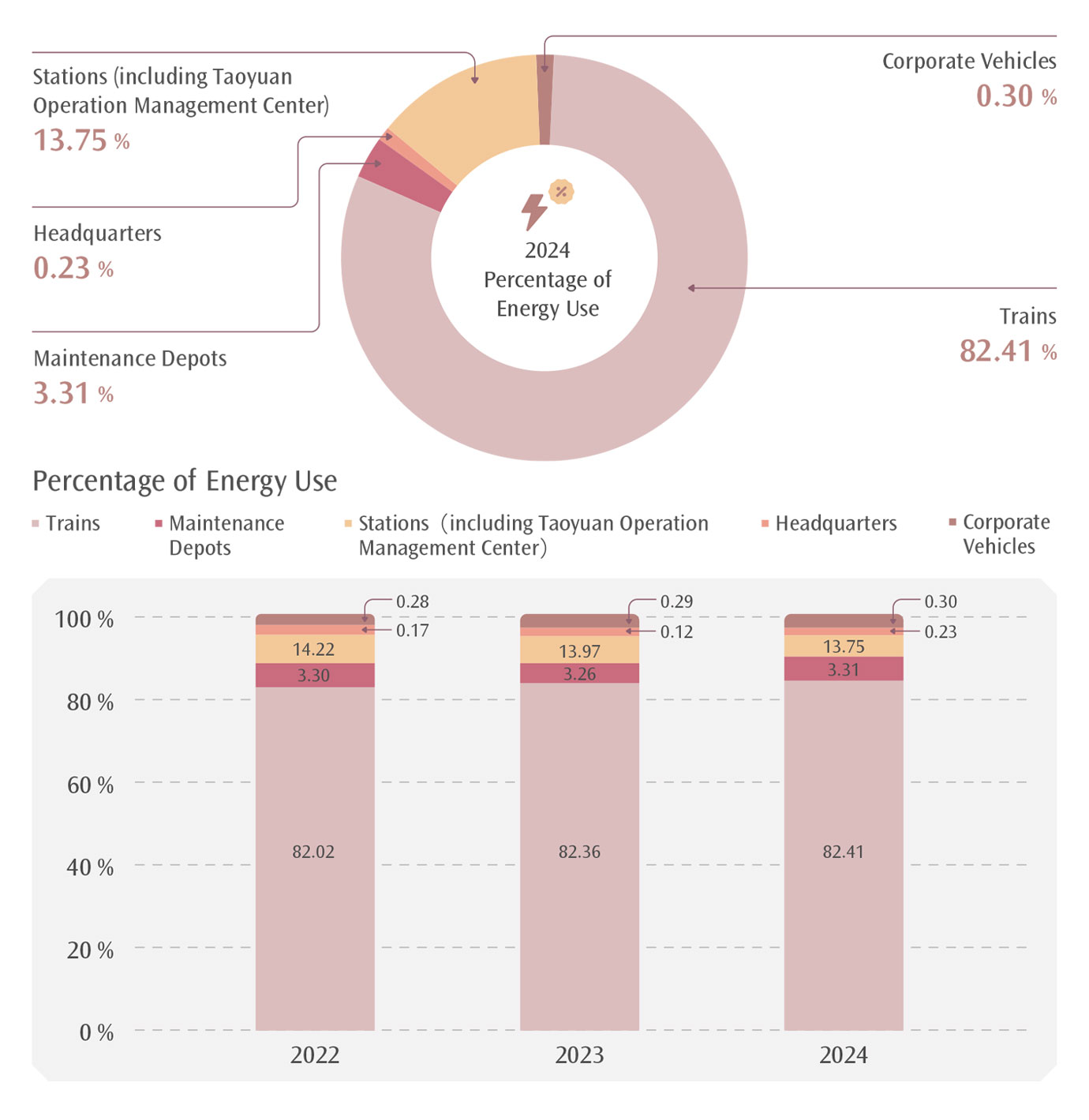
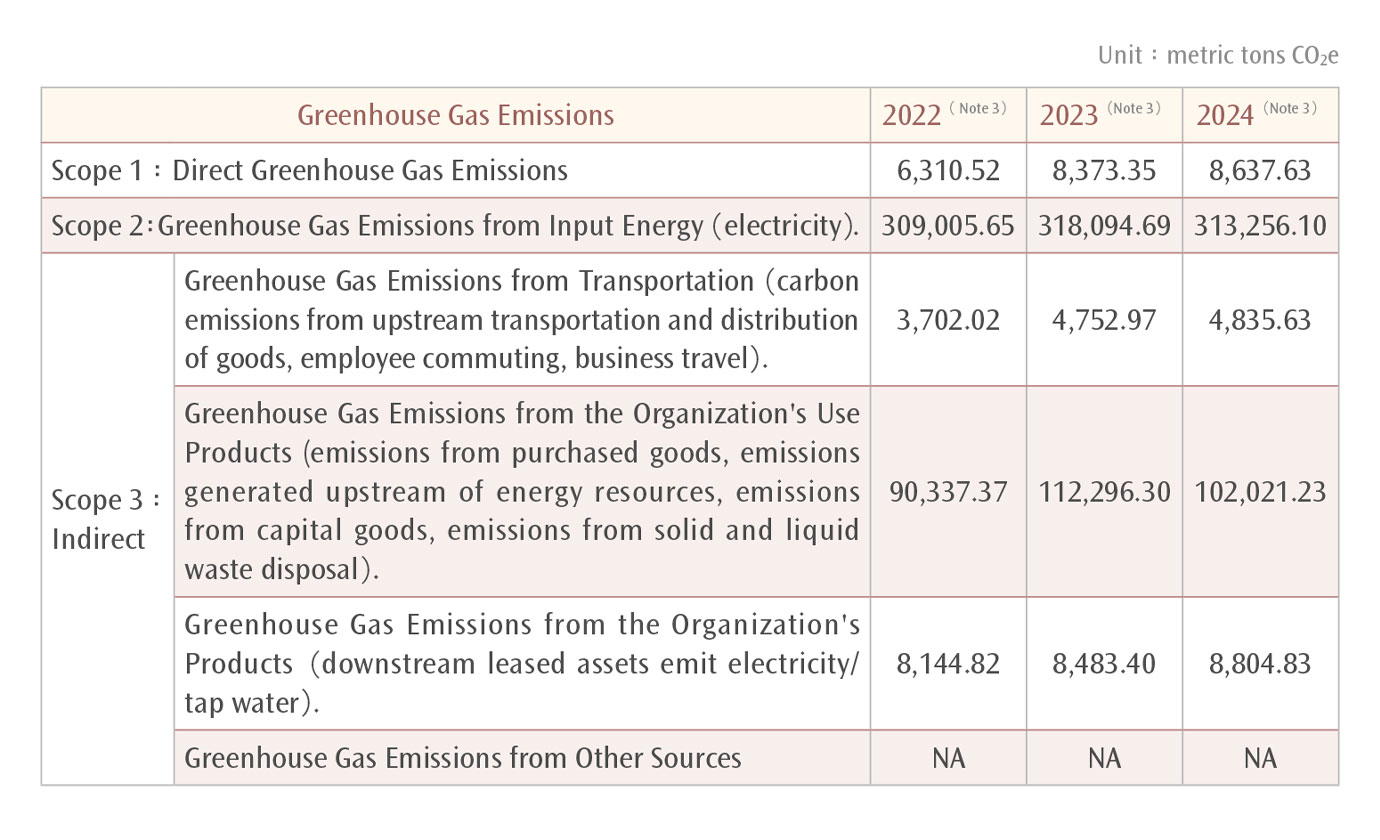
Notes:
1. Greenhouse gas emission inventory in 2022 included whole company, including 12 stations, 4 maintainance depots, Headquarters office, Taoyuan Operation Management Center and main line (trains and roadside equipment); and followed with ISO 14064-1:2018 standards which obtained in 2023,September. As the calculation of electric power emission in 2022 was updated in 2023, so the data was different from that in THSRC's 2022 and 2023 Sustainability Reports.
2. The 2023 greenhouse gas inventory and verification operations achieved a 100% coverage rate, including 12 stations, 5 maintenance depots, the Headquarters office, the Taoyuan Operation Management Center, and the main line (trains and roadside equipment). The ISO-14064-1:2018 verification certificate was obtained in September 2024; the 2024 emission verification was completed in April 2025 under the ISO 14064-1:2018 standard.
3. The emission factors for gasoline and diesel in 2022 and 2023 refer to Version 6.0.4 (June 2019) of the Greenhouse Gas Emission Factors Management Table published by the Ministry of Environment; the 2024 factors were based on the “Greenhouse Gas Emission Factors Calculation Table” announced by the Ministry of Environment on February 5, 2024.
4. Greenhouse gas emissions are calculated as electricity consumption or gasoline/diesel consumption × emission factor × global warming potential (GWP) = metric tons of CO₂ equivalent emissions. The GWP values used in the inventory are based on the Intergovernmental Panel on Climate Change (IPCC) Sixth Assessment Report published in 2021.
5. The types of greenhouse gases emitted included sulfur dioxide, methane, nitrous oxide, fluorocarbon, perfluorocarbons, and sulfur hexafluoride.
In 2024, THSRC completed the inventory of 9 categories under Scope 3, which were externally verified as well as Scope 1 and 2. The Company will continue to expand the Scope 3 inventory coverage.
Scope 3 Emission Inventory and Methodology Description (2024 Emissions)
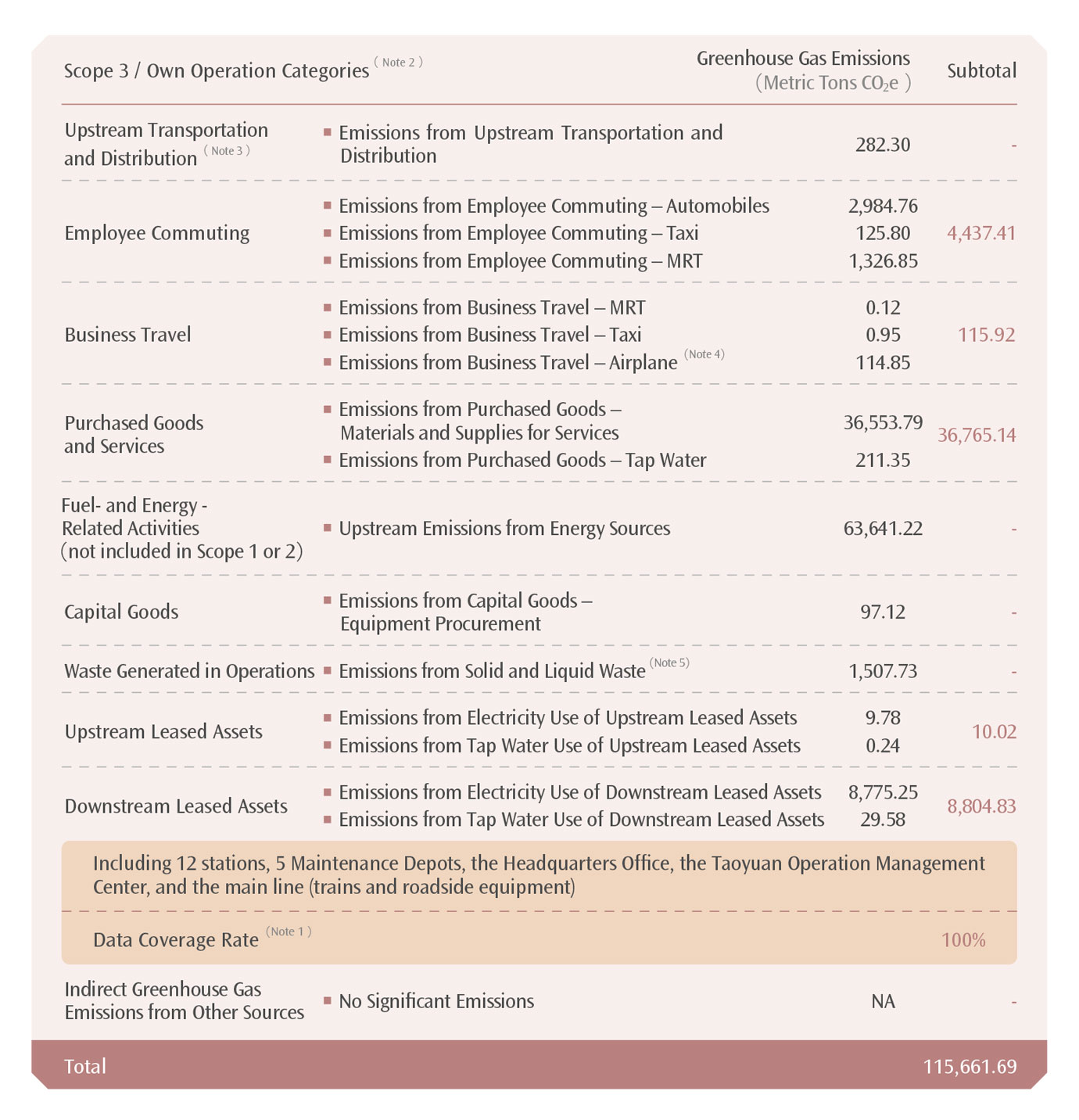
Notes:
1. Data coverage is 100%.
2. To maintain consistency in terminology disclosure within the report, the terms used follow Scope 3: Indirect Emissions of the GHG Protocol. Corresponding terms from ISO 14064-1:2018 are:
・Upstream transportation and distribution, business travel, and employee commuting correspond to "Category 3 –Indirect greenhouse gas emissions from transportation."
・Purchased goods and services, fuel- and energy-related activities, capital goods, waste generated in operations, and upstream leased assets correspond to "Category 4 – Indirect greenhouse gas emissions from products used by the organization."
・Downstream leased assets correspond to "Category 5 – Indirect greenhouse gas emissions from products provided by the organization."
3. Emissions from upstream transportation and distribution are calculated using the distance-based method, based on supplier transport distance, cargo weight, and corresponding emission factors.
4. International air travel emissions are calculated using the ICAO Carbon Emissions Calculator for each flight.
5. Waste emissions are calculated using the categorized waste method, based on Industrial Waste Report and Management System of Resource Circulation Administration Ministry of Environment. Emissions are computed according to the type of treatment method and corresponding emission factors, and transportation emissions are based on the distance-based method using waste weight, transport distance, and relevant emission factors.
Low-Carbon Trains, and Green Stations
Building Low-Carbon Trains
THSRC utilizes the industrial benefits of low-carbon transportation to offer passengers environmentally friendly, fast, and convenient transportation services while effectively mitigating the environmental impact of operations. However, in 2024, the electricity consumption per trip at THSR stations and bases is 0.961 kWh and 0.239 kWh, respectively, electricity consumption per trip has decreased year by year (see the table below). When calculated in terms of the passenger-kilometer carried by THSRC in 2024, the Company was able to reduce CO2e by 1,108,149 metric tons compared to smaller passenger cars. When calculated against the annual carbon absorption of 389 metric tons per Da-An Forest Park (source: 2019 Bureau of Energy, Ministry of Economic Affairs), this reduction is equivalent to the carbon uptake of 2,849 Da-An Forest Parks.

- “Carbon Footprint label of High Speed Rail Transportation Services” and “Carbon Footprint of Passenger Transportation Between Stations” verification certificate and label.
- In 2020, we applied to the Ministry of Environment for an extension and were awarded a renewed carbon footprint label, which valid until December 16, 2025. As we have achieved our carbon reduction commitment of reduction by more than 3% within three years (by 4.92% in practice), we were awarded a “Carbon Reduction Label.
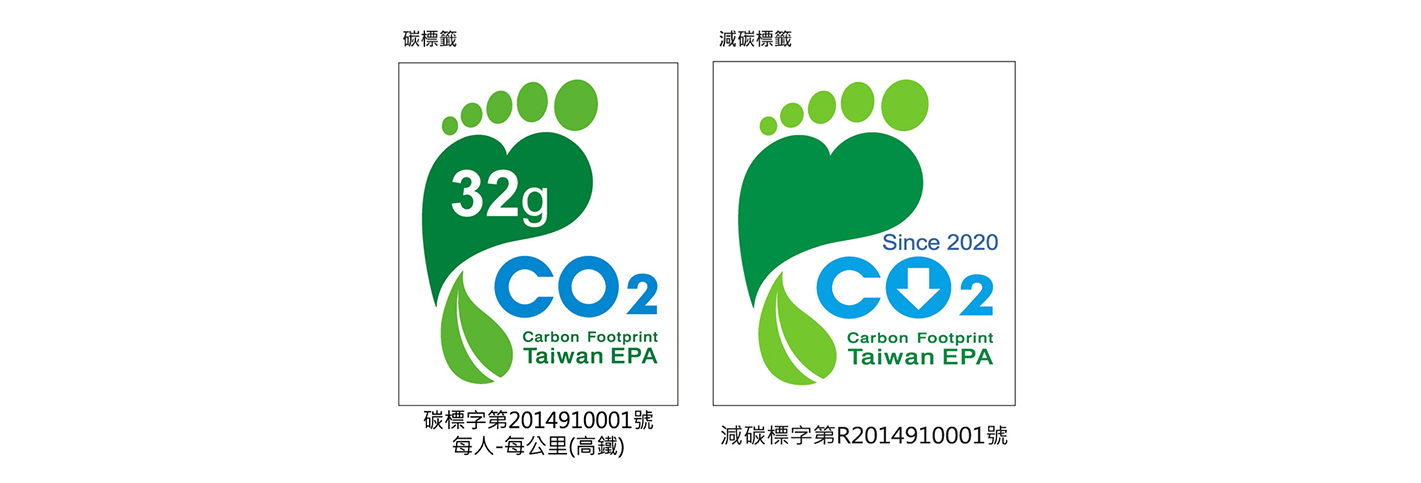
From 2010 (base year) to the end of 2024, THSRC has promoted energy-saving programs through the “Train Energy Conservation Team,” continuously improving the energy efficiency of train operations. A cumulative total of 26,909 MWh of electricity has been saved, and 13,293 metric tons of CO₂e emissions have been reduced. The table below shows the amount of electricity saving and carbon reduction in the past three years.
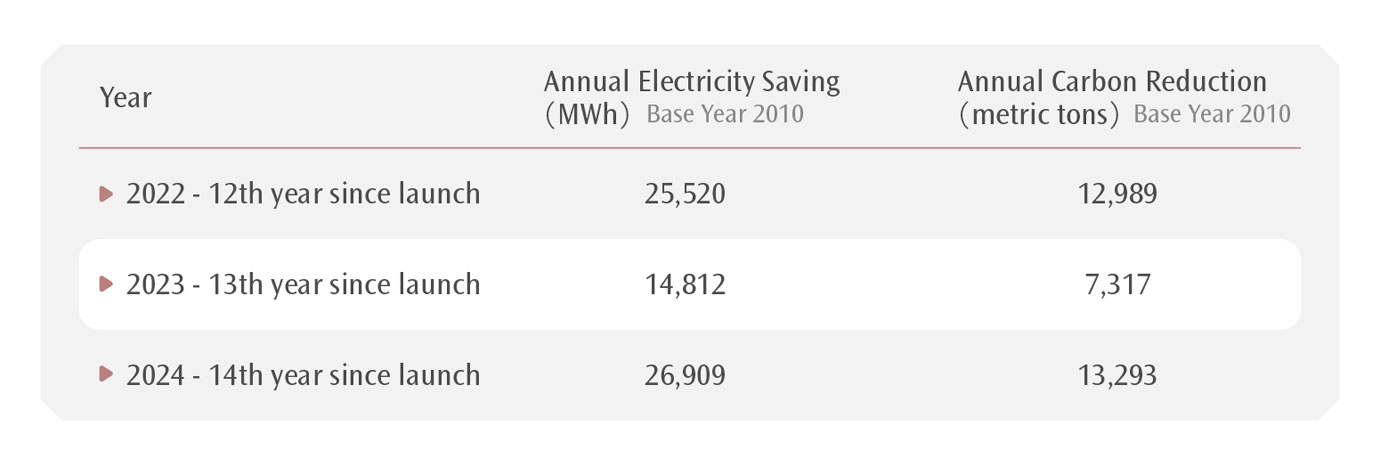
Notes:
1. THSRC used the 2010-2023 National Electric Power Emission Factor published by the Bureau of Energy and calculated emissions in 2024 using emission factors in 2023.
2. Only electricity consumption in train operation was included. Electricity consumption for lighting and air-conditioners on trains was not included.
3. The original annual carbon savings in 2023 as compared to those in 2010 were 7,332 metric tons, which was adjusted to 7,317 metric tons in the recalculation due to the adjustment of the 2023 emission factors.
Energy Management
THSRC has implemented energy-saving projects at five maintenance depots and 12 stations, and has established a comprehensive energy efficiency improvement plan to develop zero-carbon emission green stations with the continued implementation of four major energy-saving schemes “autonomous energy conservation management, reduce electricity consumption, transfer peak electricity usage, and use electricity reasonably.” HSR stations are designed with a sustainable environment concept that includes “ecology, energy conservation, waste reduction, and health.” Several energy-saving measures are implemented to suit the geographical environment of each station, reducing the load on building materials and air conditioning. THSR Miaoli Station, Changhua Station, and Yunlin Station have respectively received Diamond Level, Gold Level and Gold Level Green Building Certificates and Green Building Certification Plaques issued by the Ministry of the Interior. The maintenance depots prioritize energy reduction planning and several improvement measures for existing equipment to reduce the average energy consumption of passengers served at the stations and maintenance depots.

In response to the net-zero strategy, THSRC has built solar power generation facilities at maintenance depots and stations to align with the government's energy transition policy. However, the power generation may fluctuate due to unfavorable weather and natural disasters (such as typhoons). In 2024, the annual solar power generation reached 8,964.004 MWh. The total power generation of the four maintenance depots was 6,566.75 MWh, and the power generated was all sold to Taipower; the total power generation of the six HSR stations was 2,397.26 MWh, of which 176.292 MWh was used by the HSR station, and the rest was sold to Taipower.
Solar Power Generation at Four THSR Maintenance Depots
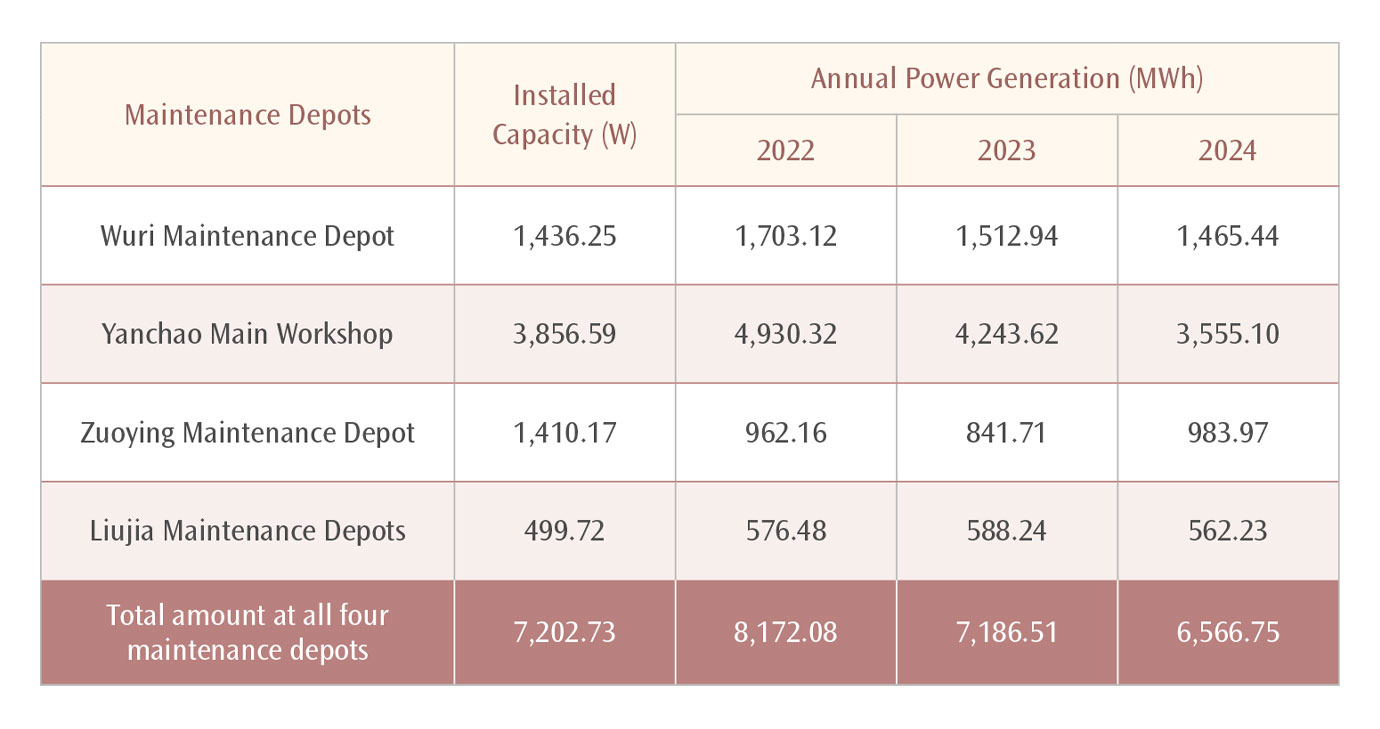
Solar Power Generation at Six THSR Station
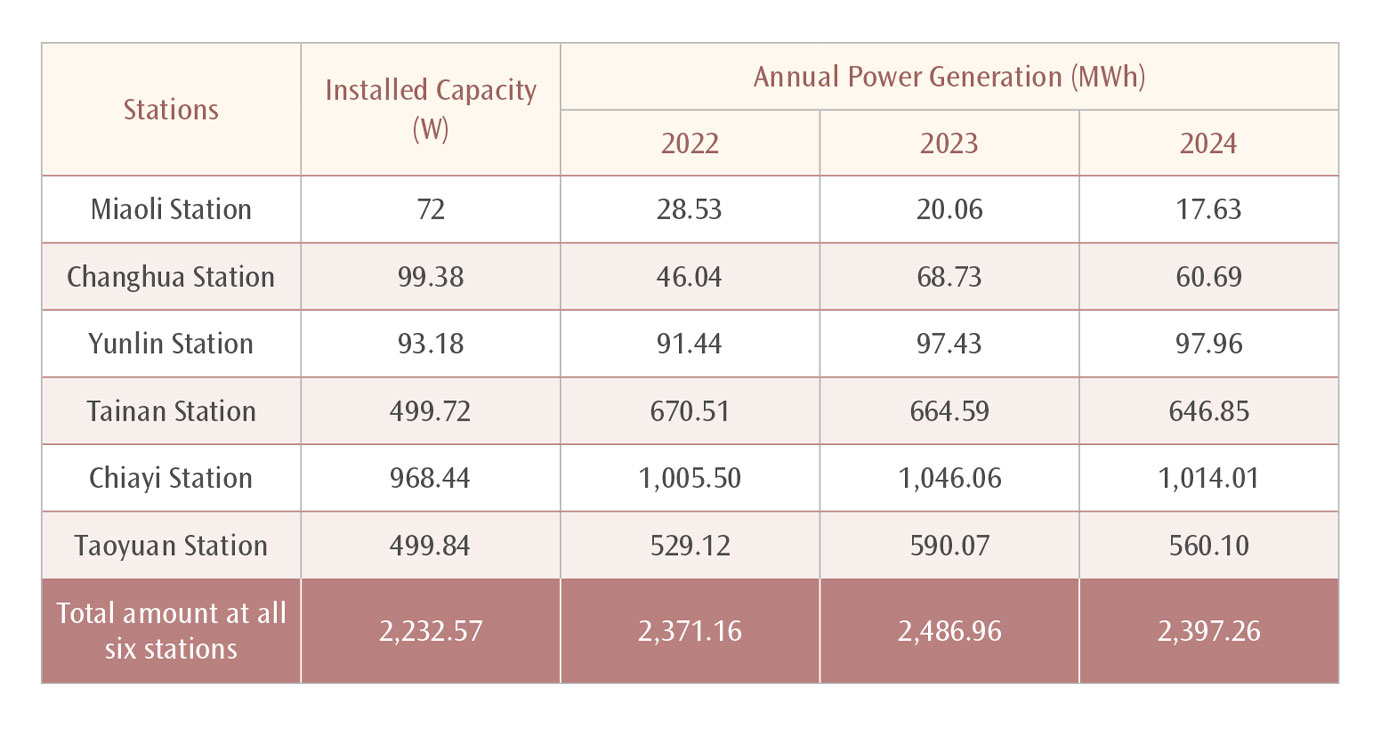
Optimization of Sustainable Operations
According to THSRC's 5-year medium-to-long term strategy plan, initiatives have been implemented to improve building energy consumption efficiency, increase electronic devices energy efficiency and also carry out green material projects. Since 2019, the Head Office has fully replaced all lighting with LED fixtures and installed heat-insulation films on curtain walls. By the end of 2024, these have saved a total of 183,960 kWh of electricity, reducing approximately 95 metric tons of CO₂e emissions. In 2024, the Taoyuan Operation Control Center also replaced 725 traditional lighting fixtures with LED tubes, which is estimated to save 47,632 kWh of electricity annually, equivalent to a reduction of approximately 25 metric tons of CO₂e.
As consumers' awareness of sustainability rises, THSRC has also reduced the use of magnetic and paper tickets through various innovative ticketing services, including the issuance of commuter passes/multiple-ride tickets and the mobile ticketing function of the T Express App. In 2024, these two services reduced ticket usage by a total of 31.11 million tickets, with a cumulative reduction of 180 million tickets to date, providing passengers with a more sustainable, low-carbon, and convenient travel experience.
In response to the paperless era, the number of digital official documents reached 52,115 in 2024, saving approximately 625,380 sheets of paper, which is equivalent to conserving 75 trees and reducing 900 kilograms of carbon emissions (calculated based on data from the Environmental Quality Protection Foundation).
THSRC has implemented three major strategies, namely water conservation, use reduction, and recycle and reuse. Meanwhile, established an Energy Conservation Project Team to hold quarterly review meetings to examine the progress of implementation and actively practice water resource management. In 2024, the water saving rate at stations reached 2.045%. THSRC continued to conduct the Tainan Station water footprint inventory for 2022 and 2023 in accordance with ISO 14046:2014 (the verification certificate was obtained in November), allowing for a more systematic reduction in water consumption per passenger.
THSRC used the water resources management tool of the World Resources Institute (WRI) for risk assessment. THSRC's water intake source is in the fifth range of 2.6-3.0 in a medium-to-low stress region. THSRC stations, maintenance depots, and THSRC's headquarters office use tap water as the source of water rather than groundwater.
Regarding waste water management, THSRC has set up waste water treatment plants at various maintenance depots and Taoyuan, Hsinchu, Miaoli, Taichung, Changhua, Yunlin, Chiayi, and Tainan Stations. Professionals with wastewater treatment licenses will classify and treat the sewage to meet the standards for effluents (Note). The remaining stations directly discharge sewage into sewers with sewage treatment fees paid regularly. Moreover, environmental management audits performed, THSRC complies with the “Water Pollution Prevention and Control Measures Plan” and the requirements of environmental laws and regulations. A report was filed on the quality and quantity of effluents from the sewage treatment plants as scheduled.

Notes:
1. The effluent standard complies with the effluent standard limit of the “specially polluted sewer system in other designated areas or places” specified under the Water Pollution Control Act, which includes water temperature < 35° C (October to April) < 38 ° C (May to September), pH value between 6.0 and 9.0, oil and fat < 10 mg/L, suspended solids < 30 mg/L, chemical oxygen demand < 100 mg/L, biochemical oxygen demand < 30 mg/L.
2. The increase of total water withdrawal in 2024 was mainly due to the increase in traffic volume by 7.07% compared with 2023.
3. Due to adjustments in unit conversion for 2024, the data in this table is slightly different from the previous data.
THSRC is committed to reducing the amount of waste and increasing the rate of recycling. The recycling of waste, including the resources generated from train maintenance operations and transportation services, as well as the recycling, clean-up, and disposal of and general industrial waste and waste at all HSR maintenance depots and stations are all processed by qualified licensed operators. Non-recyclable general industrial waste is ultimately disposed in incinerators. THSRC also manages the contractors through a contract mechanism to facilitate supervision of their compliance with relevant waste regulations. In 2024, the total amount of waste treated was 7,081.93 metric tons, and1,852.42 metric tons of waste was recycled, with a recycling rate of approximately26.2%. The recyclables are classified into waste paper, waste plastic, scrap iron and others (including scrap copper, scrap aluminum, waste lighting sources, waste lead storage batteries, and waste glass containers, etc.), covered by 31.59%, 10.72%, 35.92% and 21.77%, respectively. In 2024, no breach of contract occurred, and no leakage of oil, fuel, chemical substances, or waste occurred.
THSRC not only urges the implementation of internal waste management, but also actively encourages suppliers to take actions. In our contracts with contractors, we require them to properly clean and dispose of the waste generated. Furthermore, the awareness-increasing session in meetings on interface agreements and work meetings with contractors, we supervise each contractor's implementation of waste treatment measures through on-site audits.
In 2024, THSRC invested approximately NT$80.468 million in waste water and waste treatment. These projects included equipment maintenance, equipment expansion and repairs, coagulants, precipitants, and disinfectants, water quality inspections, commissioning of sludge collection and disposal, and outsourcing of waste collection and disposal.
| Stations | Maintenance Depots | Stations and Maintenance Depots | ||||||
|---|---|---|---|---|---|---|---|---|
| Unit: metric tons | Amount of Waste (metric tons) |
Amount of Resources Recycled (metric tons) |
Amount of Waste (metric tons) |
Amount of Resources Recycled (metric tons) |
Amount of Resources and Waste Recycled (metric tons) |
Total Amount of Waste (metric tons) |
Resource and Waste Recycling Rate | |
| 2022 | 4,288.59 | 621.99 | 565.92 | 830.23 | 1,452.22 | 6,306.73 | 23.0% | |
| 2023 | 4,675.78 | 1,016.51 | 454.57 | 1,175.37 | 2,191.88 | 7,322.23 | 29.9% | |
| 2024 | 4,774.68 | 926.26 | 454.83 | 926.16 | 1,852.42 | 7,081.93 | 26.2% | |

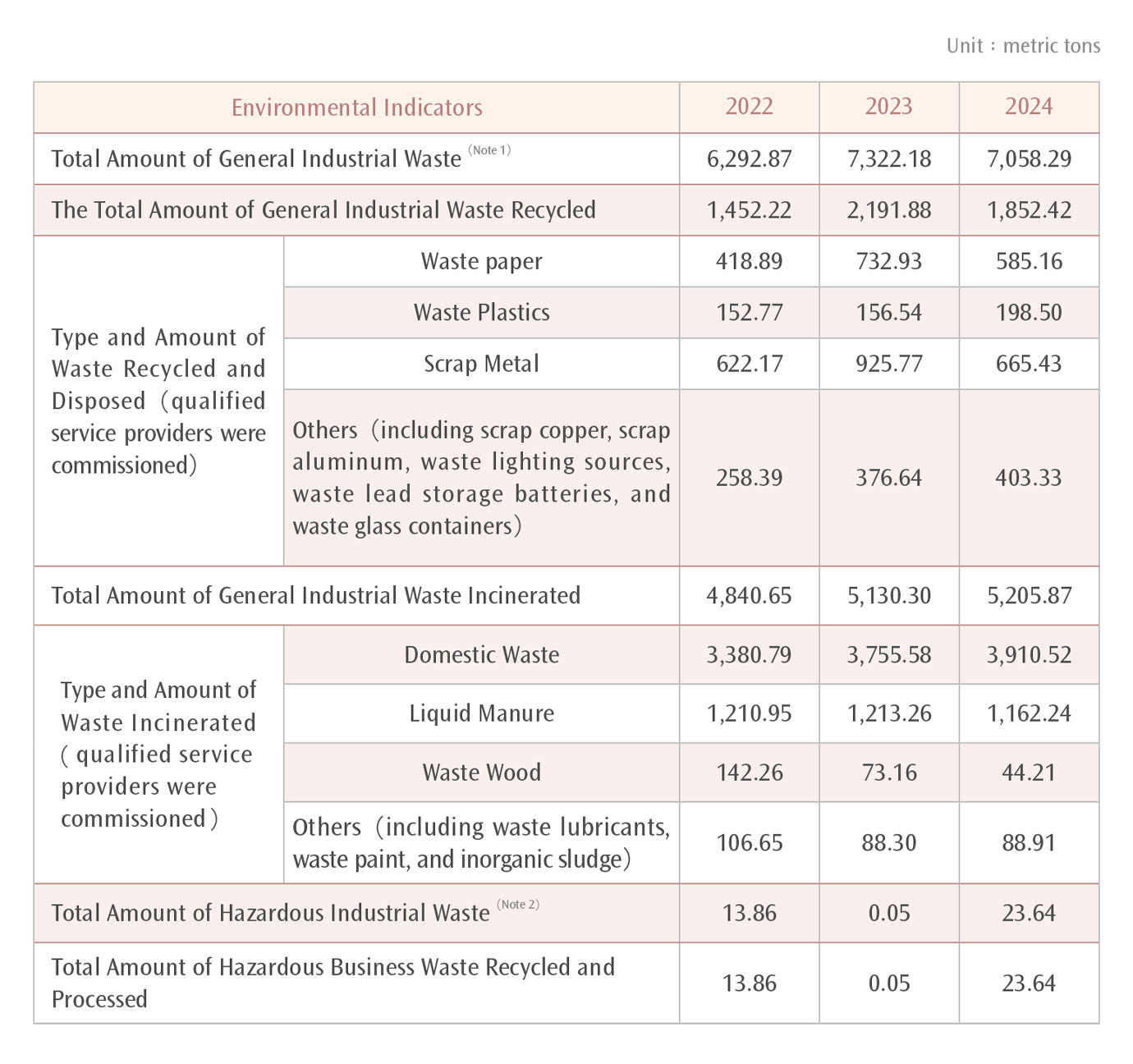
Notes:
1. The waste from the headquarters office is processed by the building management unit altogether, and the waste from trains is included in that from stations or maintenance depots for processing altogether, so the relevant data has been included in this table.
2. “Hazardous industrial waste” is nickel-cadmium batteries.
